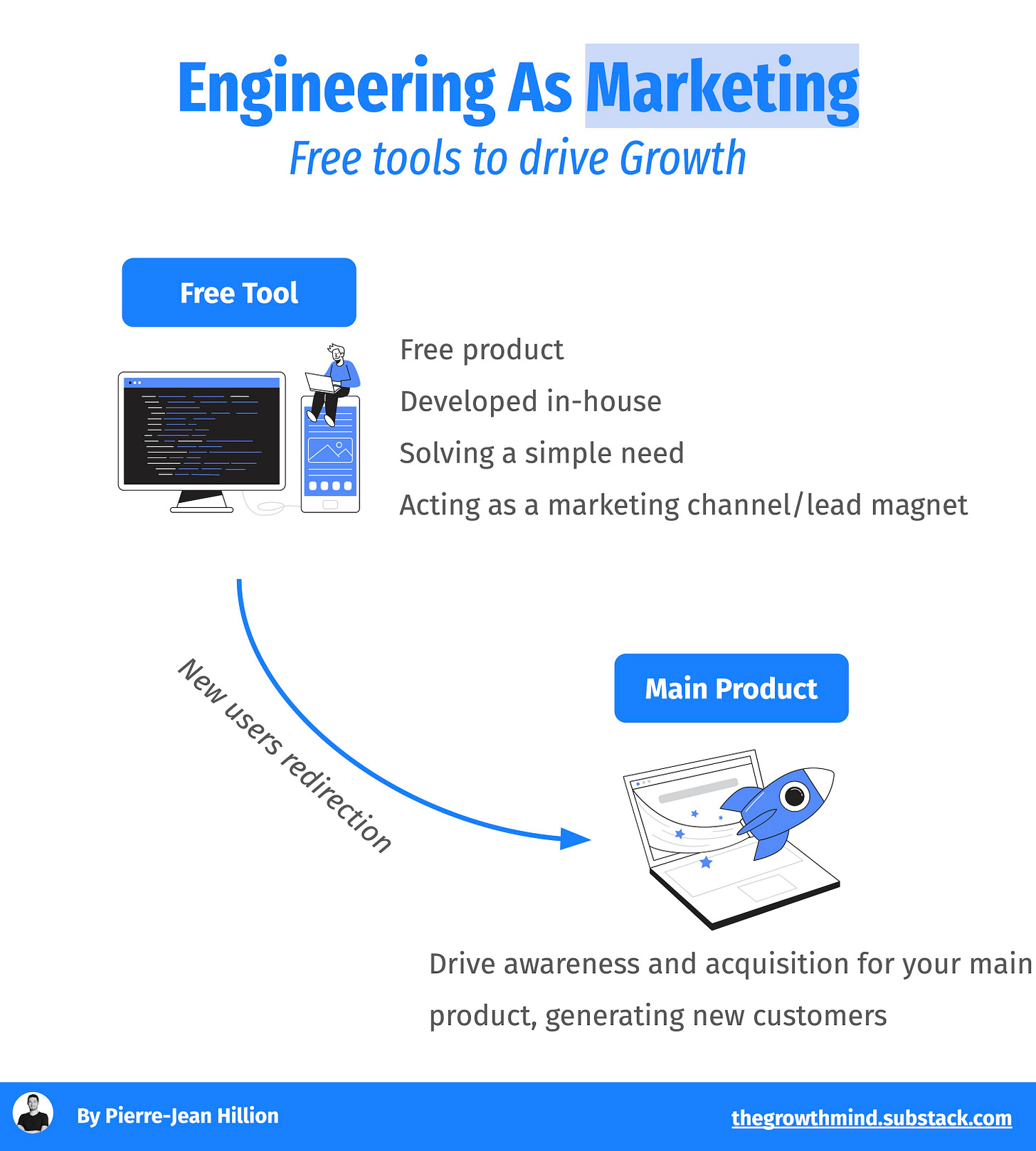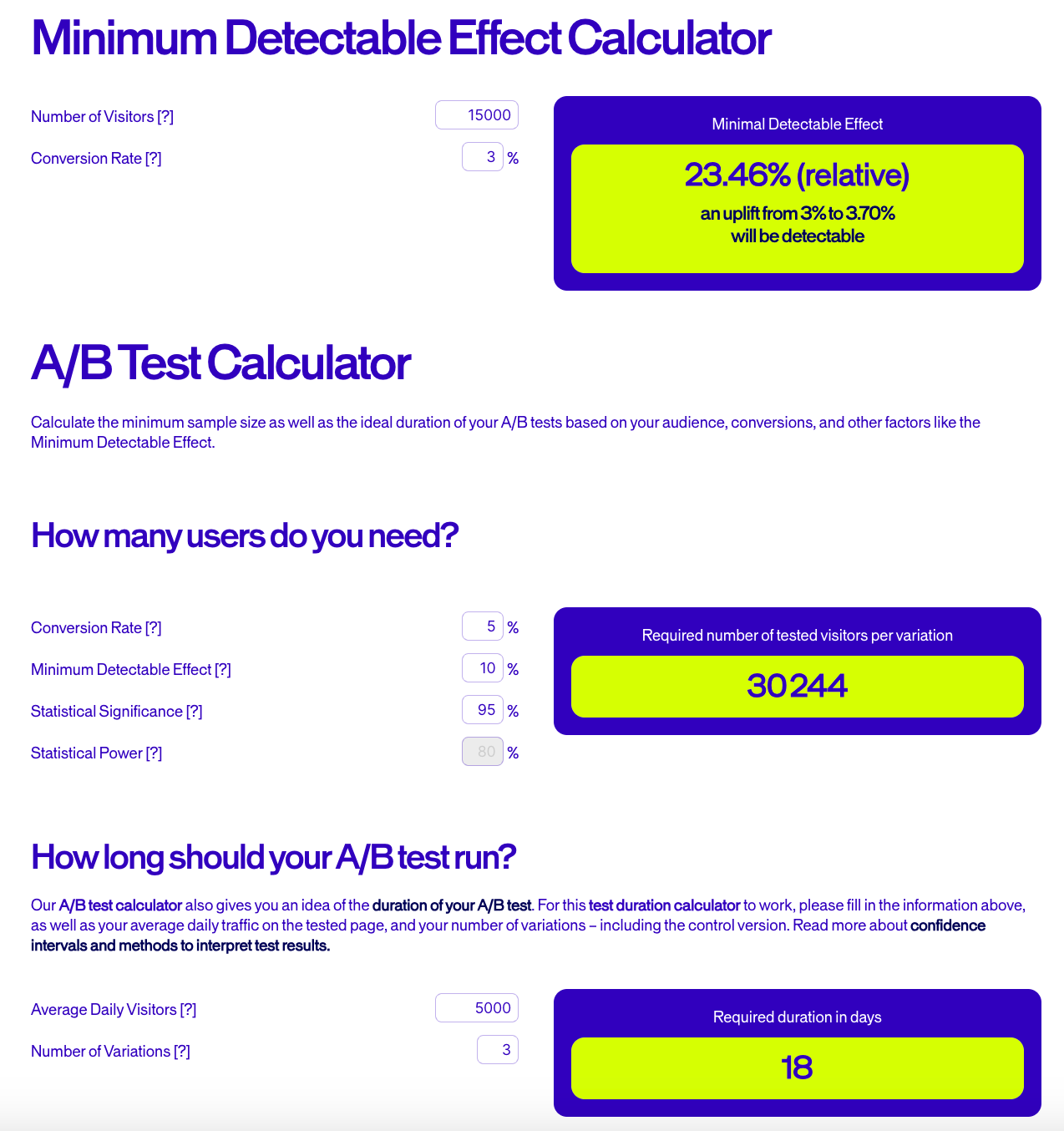Hey Growth folks 👋
In today’s edition of The Growth Mind, we talk about a powerful growth tactic to boost awareness and acquisition: Engineering as Marketing 🤖
This edition is brought to you by Folk, the all-in-one CRM for all your relationships.
Folk is probably the easiest and most beautifully designed CRM I’ve used over the past few years. With a Notion-like interface, it’s way more enjoyable to use than traditional CRMs. And the features are top-notch.
With Folk, you can:
Write personalized emails and automated sequences with AI
Find emails with the enrich contacts feature
Import contacts from anywhere (LinkedIn, Gmail, Instagram…) on the web
Centralize and sync all your contacts and interactions in one place
And, of course, you can try it for free.
PS: When you sign up to Folk with my link, you help support me and my content, so thanks in advance 🫶
Want to promote your product to 6k growth people? Discover sponsoring opportunities.
🧐 Engineering as Marketing: what the hell is that?
Have you ever seen:
A free tool,
solving a simple, unique need,
provided by a brand,
but which is not its main product?
That’s exactly what engineering as marketing is.
Engineering as marketing consists of capitalizing on your engineering capacities to build tools that help you generate awareness for your main product and acquire new users.
Those tools can be compared to lead magnets, but instead of content pieces, those are technical tools.
Engineering as marketing has 3 main benefits 👇
Increase awareness and acquisition
Thanks to a simple tool, you can attract new users to your ecosystem, who would not have been acquired directly with your main product. Even if only a small part of people using your free tool will become customers, you need to see it as a marketing channel, with its conversion rates associated.
Diversify from traditional marketing channels
When it comes to marketing, we all think about the classic channels like SEA, SEO or Social Ads directly.
But engineering as marketing is a creative way to add a new channel to your growth engine and be different than your competitors. And it’s not a one-shot, the assets created are here for a long time. You can build different tools over time and regularly promote them.
Build a product ecosystem, solving several use cases for your target audiences
Your main product is generally not designed to solve all your target audiences' needs and use cases. It can become messy to try doing it, leading to a complex product with an addition of features and blurry messaging. But the secondary tools you build for engineering as marketing can do this job, without negatively impacting your main product strategy.
Engineering as marketing can take several formats:
Interactive Templates and frameworks
Knowledge bases and courses
Technical tools for developers
Calculators and simulators
Quizzes and assessments
Content creation tools
Trackers and planners
Interactive builders
APIs and data sets
The possibilities are endless. And that’s the magic of engineering as marketing. It goes far beyond the classic lead magnets you can build.
One thing that characterizes engineering as marketing is that the tools you build are generally free. They should play the role of a marketing lever, not be a revenue line. The focus of this tactic is on virality and acquisition rather than monetization.
💡 How to properly do Engineering as Marketing
Identify your audience's needs
As for every product, the tools you build for Engineering as Marketing purposes should solve one of your audience’s main pain points.
There are many ways to understand what your users need:
User interviews: Discussing with your current customers or people in your target audience, by conducting interviews, can help you find specific problems they need to solve.
Keywords analysis: Doing keyword research, with tools like AhRefs or Semrush, is also a smart way to see what people search. If you can build a tool that answers a “how-to” question that is highly searched by your audience, that’s the jackpot.
Support tickets: Finally, analyzing what your customers ask for in your support tickets can help you learn a ton about their needs and problems.
You can combine those different sources to have a clear understanding of what free tool could be a great opportunity to build.
→ As building a tool can require some time, it’s crucial to derisk the approach by making sure you’re not allocating precious engineering time to a useless product that will have no impact on your acquisition.
Build a simple tool, solving a single use case
As you primarily build a tool for marketing purposes, it should be easy to access and use.
Solve a single use case: You’re not building an entire software with multiple features, only a single problem solver.
Avoid complexity: The tool should be easy to use, without any long onboarding or tutorial needed.
Remove access barriers: Make sure to have a tool accessible without friction. Avoid long qualification forms for sign-up. You can even consider having your free tool ungated, meaning no sign-up/email is required to access it. It will increase the share of people you deliver value to.
Promote the tool
To make your Engineering as Marketing tactic successful, you need to promote your tool, as it is a lead magnet.
You can use dozens of channels to promote your Engineering as Marketing tool 👇
If you have a significant on Social Media, that’s the perfect place to do it. A great free tool can drive engagement.
Free tools can rank pretty well on SEO. Even better than your main website pages or blog articles sometimes. Coming back to the keyword research part we talked about above, I think Engineering as Marketing is a great tactic to be visible on search engines.
Paid Channels (SEA, Social Ads) can be considered too, if the leads you acquire through your free tool convert well, at a reasonable CAC.
Finally, you can think of sharing it with your current users/customers through your owned channels. It will serve a Loyalty/retention objective, which is generally not the main one with engineering as marketing, but can make total sense too. As long as it solves one of their problems.
🥷 5 powerful examples of Engineering as Marketing
Hubspot Website Grader
Hubspot is one of the best companies when it comes to inbound strategies. And Engineering as Marketing is one of them. So as always, they’re a great inspiration.
The website grader allows you, through a simple website URL, to get a dedicated audit of your website performance based on 4 criteria (performance, SEO, Mobile, and Security).
What’s great in this example?
Super easy to use: you just need to add your website URL and an email address to get your results.
Immediate value delivered: in a few seconds, you get a website rating, with areas of improvement.
Contextual and visible call to action: The “Get the Free CMS” is visible but not intrusive, and makes total sense in this context. Would love to know the % of users that convert to the Free CMS upgrade.
Ahrefs keywords generator
Ahrefs is a well-known SEO tool.
They’ve built a Free keyword generator, which is particularly helpful to get an idea of the competition and volumes of some keywords.
What’s great in this example?
One-click to get value: As with the previous Hubspot example, you only need to add a keyword and the generator does its job.
No sign-up required: I particularly like free tools that are ungated (no sign-up or email required) as it removes friction to the minimum possible.
Contextual and visible call to action: The “See Pricing” CTA is clearly visible and encourages you to see more metrics.
A/B tasty calculator
A/B Tasty is a software to do…A/B testing as you probably guessed. They’ve built a tool to calculate all you need to run an A/B test properly.
I’ve personally used it several times over the past few years.
What’s great in this example?
Solves complex calculations in seconds: As running A/B tests properly can become tricky when it comes to calculating your minimum detectable effect or sample size, this calculator is super useful. It solves a simple need, but that can lead to complex calculations and errors.
Clear wording/explanations: The wording they use (eg. “no PHD in mathematics required”) outlines the benefits of the calculator. The explanations of each term and the instructions are concise and clear.
No sign-up required: The calculator is easily accessible on their website, without any email asked.
However, we don’t have a clear and contextual CTA outlining A/B Tasty is a perfect solution to run your A/B tests on this simulator (apart from a header CTA at the top of the page). That’s an obvious improvement in my opinion.
Contrast Free tools suite
Contrast is a webinar tool. So they decided to build a free tools ecosystem around their main webinar product.
What’s great in this example?
Free tools ecosystem: Contrast is delivering value to its audience by building different free tools, creating an ecosystem where people can use several Contrast free tools, as well as their main one.
One simple need solved by each tool: Each tool tackles a single use case. They don’t try to have a one-size-fits-all free tool. Instead, they target a very specific problem with each of them.
Everything’s ungated: You can access each tool without sign-up required, in one click. No unnecessary friction.
Shopify Business Name Generator
And we finish our examples with Shopify, the well-known E-commerce platform.
They’ve recently launched a Business name generator powered by AI (fancy, isn’t it?). A smart way to target people seeking to launch their business soon.
What’s great in this example?
Immediate value: You tell Shopify what you do, and you receive tens of business name ideas instantly.
A smart way to onboard people on Shopify: When people click on “Get name”, they start entering a Shopify sign-up funnel. They probably lose a lot of people at this step, but also capture high-intent leads.
Apart from the Business Name Generator, Shopify has leveraged deeply Engineering as Marketing by creating a great free tools ecosystem too, solving different use cases. Smart move.
All the Engineering as Marketing examples we’ve seen have the same patterns:
Tools are free.
They solve a simple, single use case.
Value is delivered quickly, without long onboarding needed.
Ecosystems of free tools are built around the main product.
Engineering as Marketing possibilities are amazing, it’s up to us to leverage them 🚀













This is a great read. After we launched YouTube Summary with ChatGPT, it has been bringing us huge traffic and sign-ups to Glasp. Thanks to YouTube Summary, our user base has increased to more than 10x. It's a simple use case app, so I think it fits the engineering as marketing.
Memo to myself: https://glasp.co/kei/p/9c51a7e93bcf85a42c53